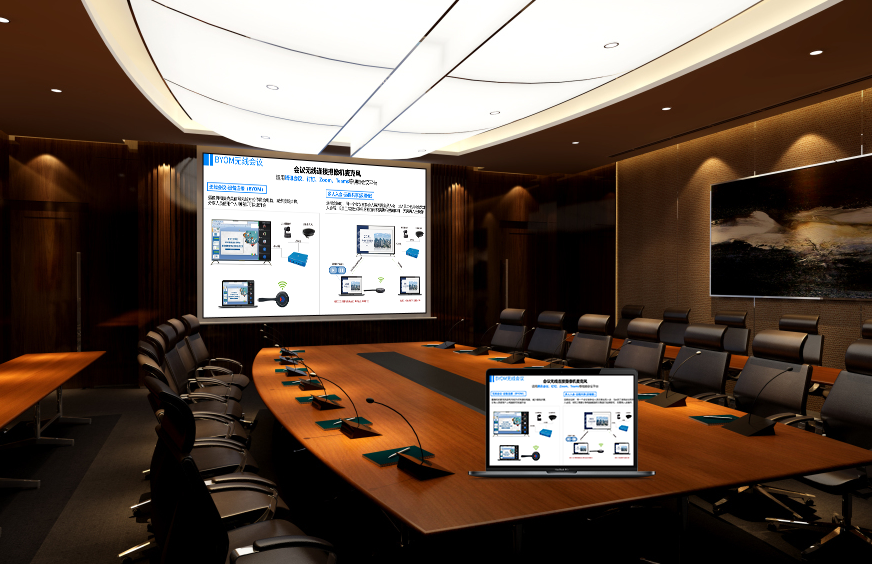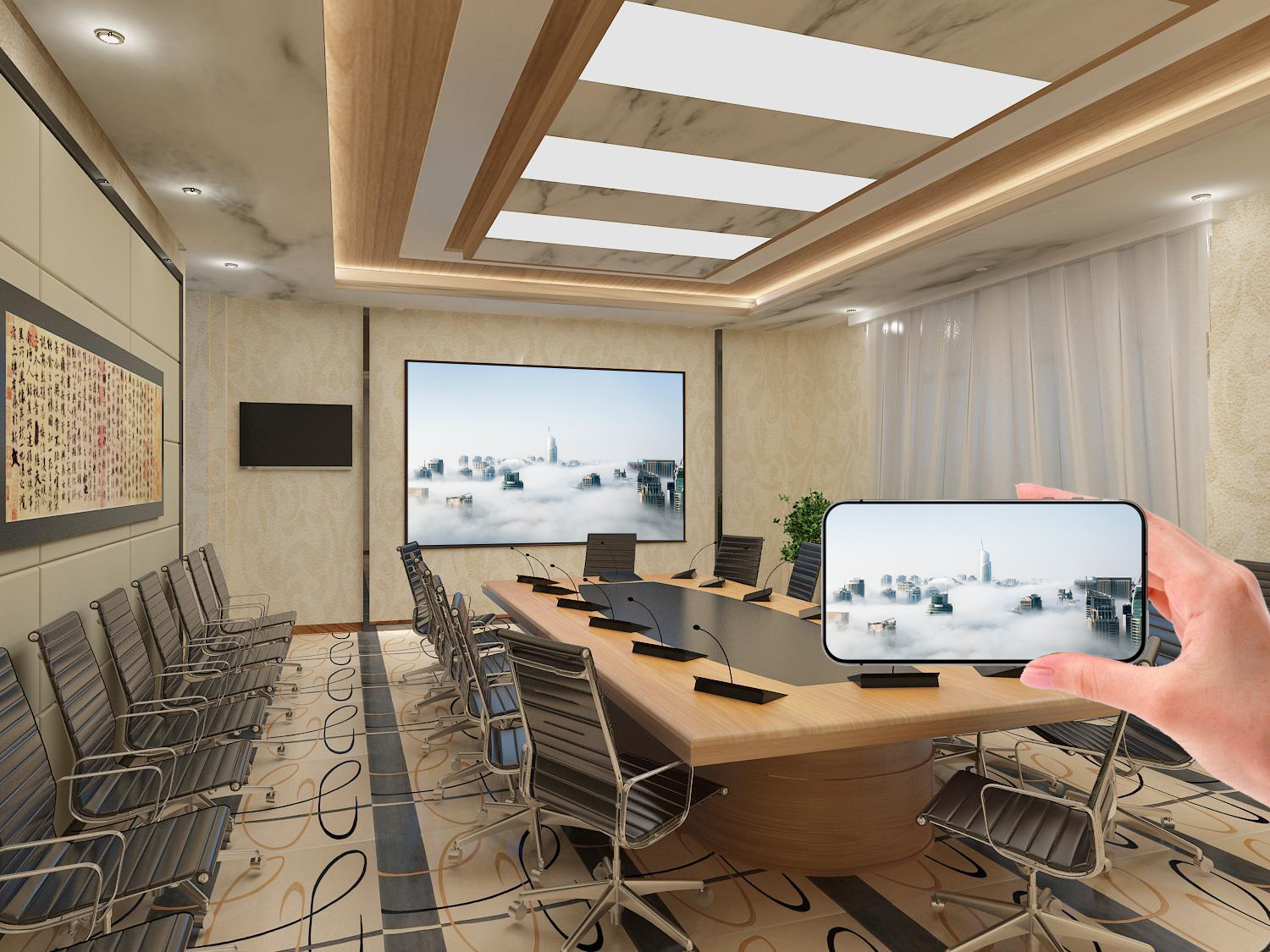Built-in Video Conference Rooms: Making Remote Collaboration Feel Like You’re There
Built-in video conference rooms deeply integrate hardware with meeting systems, breaking down the barriers of traditional remote meetings like scattered devices, complex connections, and choppy interactions. They make remote teams feel as if they’re in the same room, enabling efficient communication and collaboration, and redefining the remote meeting experience.
I. Seamless All-Device Integration for Zero-Hassle Meeting Prep
(I) All-in-One Hardware and Software
These rooms integrate an HD camera, a microphone array, smart speakers, and the meeting system, so there’s no need to connect extra devices. Walk into the meeting room, tap the screen, or say a wake word, and the system automatically starts the camera and adjusts the microphone volume. Meeting prep is done in 30 seconds. Whether it’s a head office employee or a remote colleague, everyone can join through the same interface, avoiding connection failures caused by different device models.
(II) Flexible Multi-Terminal Access
It supports devices like computers, phones, and tablets joining quickly via a QR code, link, or meeting ID. An employee on a business trip can join with a phone, and the screen automatically adapts to a vertical display. A team in the office can share documents from a computer, and the screen content is synchronized in real-time to the main room display. A team member working from home can speak from a tablet, and the camera automatically tracks their face, ensuring they are always centered and clearly visible to all participants.
II. Immersive Interactive Experience for Seamless Remote Communication
(I) HD Audio and Video for a Live Feel
A 4K Ultra HD camera supports a 120° wide-angle view, showing the entire conference room. A microphone with an 8-meter pickup radius accurately captures speech, while smart noise reduction filters out background sounds like keyboard clicks and air conditioning. The speakers use a 360° surround sound design, making remote voices sound clear and three-dimensional, as if the person is standing in the center of the room. When discussing a proposal, remote team members can clearly see details on a blueprint and a speaker’s micro-expressions, reducing communication misunderstandings by 60%.
(II) Real-Time Collaboration to Deepen Interaction
It supports features like screen sharing, whiteboard annotation, and real-time document marking, with synchronous responses for remote and local participants. In a product review meeting, the head office team can display a design drawing on the main screen, and a remote designer can use their phone to annotate suggested changes. The annotations appear in real-time on everyone’s screen. In a project progress meeting, a remote member can hand-draw a flowchart on a whiteboard, and a local colleague can use a stylus to add details, making collaboration feel like they are all sitting around the same table.
III. Smart Scenario Adaptation for More Efficient Meeting Management
(I) Spatial Awareness and Automatic Adjustment
Built-in sensors can detect the number of people and light intensity in the meeting room, automatically adjusting the camera’s field of view and screen brightness. In a large meeting with 20 people, the camera automatically switches to wide-angle mode. For a small discussion with 3 people, it focuses on the speaker’s area. When the lighting is poor, the screen brightness automatically increases to ensure the remote team can see the local team clearly.
(II) Intelligent Management of the Entire Meeting Workflow
It supports features like scheduling meetings, automatic recording, and generating meeting minutes. After a meeting is scheduled via calendar software, the system wakes up the devices 10 minutes in advance. During the meeting, it automatically identifies speakers, generates time-stamped text minutes, and links them to corresponding audio and video segments. After the meeting, the minutes and recordings are automatically sent to participants’ emails, eliminating the time spent on manual organization.
IV. Multi-Scenario Application to Unleash the Value of Remote Collaboration
(I) Cross-Regional Corporate Meetings
- Head Office and Branch Collaboration: A product launch at the Beijing head office can be live-streamed through video conference rooms. Teams at Shanghai and Guangzhou branches can ask questions in real-time, with the main screen displaying the presentation and the remote teams’ faces in a split-screen view, making interaction feel like it’s happening live. After the meeting, each branch can continue discussions in their local rooms, and their solutions can be synced with the head office with one click, improving decision-making efficiency by 50%.
- Remote Client Visits: When an in-person visit is not possible, the rooms can be used to show clients a factory or product details. The client can use their phone to view the meeting room in 360° and remotely control the camera to focus on areas of interest, providing a communication experience that’s comparable to an on-site visit.
(II) Remote Education
- Urban-Rural Synchronized Classrooms: An urban teacher can lecture in a room, and students in a rural classroom can participate in the interaction through their local room. Hand-raising and answer feedback are synchronized in real-time. When the teacher explains a problem on the whiteboard, the rural students’ problem-solving steps can be mirrored to the main screen, allowing for personalized guidance as if it were a one-on-one session.
- Academic Seminars: Experts from different countries can participate remotely through the rooms. Paper presentations and formula derivations are displayed in real-time on a shared whiteboard. The real-time translation feature enables opinions from different countries to collide without barriers, allowing academic exchange to transcend geographical limitations.
(III) Remote Medical Consultations
- Multi-Hospital Joint Diagnosis: A local hospital can upload patient medical records and images through the rooms. Experts from a top-tier hospital can view them remotely, annotate key information, and guide the local doctors to adjust their examination plan. The entire consultation is recorded and can be used as a teaching case for future analysis.
- Remote Surgical Guidance: A senior surgeon can watch a real-time feed from a local operating room in a room, using voice and annotation features to guide the surgical steps. They can quickly provide solutions during an emergency, improving surgical safety.
The core of built-in video conference rooms is using technology to eliminate the sense of distance that comes with remote work. It transforms device collaboration from “manual connection” to “automatic response” and interaction from “one-way transmission” to “two-way co-creation.” Ultimately, it makes the remote collaboration experience indistinguishable from an in-person one, allowing every participant to focus on the content itself, not the technical operation.